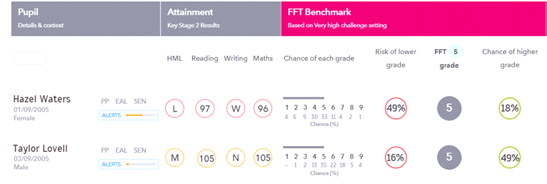Datafication of education and automated inequaities
Some musings this week on datafication and Fischer Family Trust Data (FFTD).
The Fischer Family Trust describes
its mission as to 'help children achieve their very best’ by ‘providing expert
data and literacy tools to support schools globally in improving pupil outcomes’
(fft.org.uk, 2017) and has developed a data system for pupil performance which
is now used by the majority of schools in England and Wales. The system (known
as FFTD) calculates estimated attainment targets for school children by
analysing the performance data of students from the previous year with the same
prior attainment in their previous nationally benchmarkable Key Stage
assessments (for English secondary school pupils this would be Key Stage 2),
the same gender, and the same month of birth. The analysis generates predictive
targets for pupil attainment at the next nationally benchmarkable Key Stage,
which for English secondary school students would be Key Stage 4 (GCSE).
The target looks something like
the examples below, in which, as a result of the application of the three
indicators, both students have been assigned GCSE targets of grade 5.
(fft.org.uk, 2017 – Date Accessed: 31.10.22)
It is important to say that,
typically, school children in England are informed of their target grades and
encouraged to work hard to meet and exceed these. This is for two main reasons.
First, yearly school performance is judged on a value called ‘Progress 8’ which
is calculated by analysing the extent to which a school’s student body exceeds
their expected performance at the end of a Key Stage. A school with a poor Progress
8 score will be automatically inspected by Ofsted, the English school
inspectorate. Second, Ofsted have historically used value added attainment data
as a key factor when making judgements on the effectiveness of a school.
Since 2019, attainment data has
been used more judiciously by school inspectors as an indicator of school
performance, nevertheless, Ofsted still state that schools in which ‘The
attainment and progress of students are consistently low and show little or no
improvement over time, indicating that students are underachieving considerably’
(2019) will be deemed as Inadequate.
I have a number of thoughts in
response to the use of FFTD in schools. First, I think that it is good that
schools are keen to know that their pupils are successful. Comparing their
achievement to that of “similar” peers is a way to do so. I feel uneasy,
however, about the three indicators that are used to determine what constitutes
a “similar” pupil. Prior attainment is little more than a snapshot of
performance at a single moment in time and, although there is plenty of
evidence to support gender and month of birth as strong indicators of academic performance,
the sociology of the selection of just these two demographic indicators needs
deep exploration. A 1991 study by Gordon and Kravertz found a larger gap in
terms of cognitive functioning between left and right handed people than
between males and females, for example. If this is having a greater impact on
attainment than gender, should this be accounted for in FFTD?
We also have an issue when it
comes to the trustworthiness of the data we are giving to our young people, and
the expectations and social pressures that go hand in hand with that. In the
example above, Hazel and Taylor have been generated the same GCSE target grade.
Taylor, however, is much more likely to achieve it than Hazel. In fact, 84% of “similar”
students to Taylor will achieve grade 5 and above, whereas for Hazel the likelihood
is 51%. Is it fair, therefore, to assign both with the same target grade. For
me, this raises an important question of what data looks like at the human end.
On a whole school level, it might be useful for a school to look at what might
be the expected outcomes for their cohorts of students. On an individual level,
however, the designation of a target grade to a student has implications for that
person’s motivation, engagement and wellbeing. Certainly, the FFTD system
assumes a linear progression from the age of 11 to 16 which is very far from the
reality for a large number of young people.
At the same time, the generation
of a single grade based on performance in literacy and numeracy at the age of
11 isn’t necessarily as strong indicator of performance in the varied subject
offer studied by most 15-16 year olds. Is Hazel as likely to gain a grade 5 in Science
as she is in Art, Music or Geography?
And finally, it would be
interesting to explore the extent to which the tool developed by the Fischer
Family Trust helps the organisation to succeed in its core mission: ‘to help
children achieve their very best’ (fft.org.uk, 2017). This data tool has a fairly
limited view of what ‘their very best’ looks like: progress in academic
attainment. With the greater focus on curriculum content that is the result of
the 2019 School Inspection Framework, there is perhaps new demand for school
data systems that do more than a comparison between the attainment of similar
students.
https://fft.org.uk/about-fft/ (Date
Accessed: 31.10.22)
https://www.gov.uk/government/publications/school-inspection-handbook-eif/school-inspection-handbook
(Date Accessed: 31.10.22)
Gordon, Harold W. & Kravetz, Shlomo,
‘The influence of gender, handedness, and performance level on specialized
cognitive functioning’, Brain and Cognition, Volume 15, Issue 1, 1991, Pages
37-61.

Comments
Post a Comment